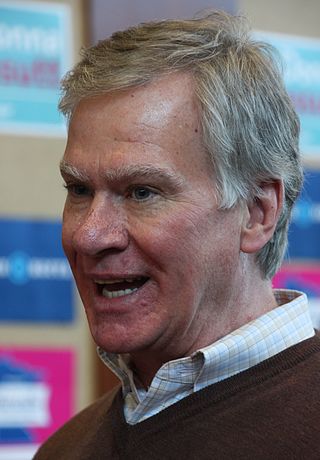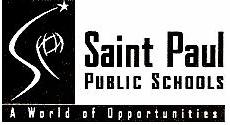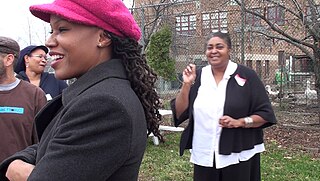
Saint Paul is the capital of the U.S. state of Minnesota and the county seat of Ramsey County. Situated on high bluffs overlooking a bend in the Mississippi River, Saint Paul is a regional business hub and the center of Minnesota's government. The Minnesota State Capitol and the state government offices all sit on a hill close to the city's downtown district. One of the oldest cities in Minnesota, Saint Paul has several historic neighborhoods and landmarks, such as the Summit Avenue Neighborhood, the James J. Hill House, and the Cathedral of Saint Paul. Like the adjacent city of Minneapolis, Saint Paul is known for its cold, snowy winters and humid summers.

St. Catherine University is a private Catholic university in Saint Paul, Minnesota. It was established as one of the first institutions of higher learning specifically for women in the Midwest and was known as the College of St. Catherine until 2009. St. Kate's offers baccalaureate programs for women as well as graduate and associate programs for women and men.

Christopher B. Coleman is an American politician and lawyer who served as the 54th Mayor of Saint Paul, Minnesota between 2006 and 2018. He defeated incumbent mayor Randy Kelly in 2005 and took office on January 3, 2006. He was later succeeded by city councilman Melvin Carter on January 2, 2018.

Saint Paul Central High School is the oldest continuously operating high school in the state of Minnesota, United States. Founded in 1866 in downtown Saint Paul, Central has educated many leaders in business, government, literature, arts, sciences, and education throughout the state of Minnesota and the United States.

Cretin-Derham Hall High School (CDH) is a private, co-educational Catholic high school in Saint Paul, Minnesota operated by the Archdiocese of Saint Paul and Minneapolis. It is co-sponsored by the Brothers of the Christian Schools and the Sisters of St. Joseph of Carondelet.

Harding Senior High School is a public comprehensive high school located on the East Side of Saint Paul, Minnesota, United States. The school is one of the nine high schools in the Saint Paul Public School District and is the largest high school in the city of Saint Paul, with enrollment at approximately 1,908. The school was opened in 1926 as the second high school on the East Side, after Johnson Senior High School. Harding is part of the IB Diploma Programme. Harding is a member of the Minnesota State High School League and the athletic teams compete in the Saint Paul City Conference.

The Saint Paul City Conference is the athletic conference for seven high schools in the city of Saint Paul, Minnesota, United States. Much like the divisions in professional sports, the Saint Paul City Conference is one of many in the state that divides schools in close proximity into different conferences. It is the second oldest conference in the state behind the Minneapolis City Conference. The conference officially began on Friday, October 28, 1898 when Central High School and Mechanic Arts High School played the first football game between the schools.

Johnson Senior High School is a comprehensive high school for grades 9 to 12 in Saint Paul, Minnesota, United States. Originally named Cleveland High School, the school was renamed after Minnesota governor John A. Johnson in 1911. Johnson is the second oldest high school in the Saint Paul Public Schools district and is only surpassed in age by Central High School. The school has operated in three different buildings since 1897, all located on the East Side of Saint Paul.
Saint Paul, Minnesota contains many educational institutions from grade school to high school, college and beyond. A number of educational "firsts" have happened in Saint Paul. Hamline University, the first and oldest college in Minnesota, was founded in Saint Paul in 1854. In 1991, Minnesota became the first state in the United States to pass legislation allowing the existence of charter schools. The following year, the first charter school in the nation, City Academy High School, was established in Saint Paul. The oldest library in Minnesota, the Minnesota State Law Library, was opened in 1849.

Minneapolis Public Schools (MPS) or Special School District Number 1 is a public school district serving students in pre-kindergarten through twelfth grade from Minneapolis, Minnesota. Minneapolis Public Schools enrolls 36,370 students in public primary and secondary schools. The district administers about one hundred public schools including forty-five elementary schools, seven middle schools, seven high schools, eight special education schools, eight alternative schools, nineteen contract alternative schools, and five charter schools. With authority granted by the state legislature, the school board makes policy, selects the superintendent, and oversees the district's budget, curriculum, personnel, and facilities. Students speak ninety different languages at home and most school communications are printed in English, Hmong, Spanish, and Somali.

Arlington Senior High School was a public high school in Saint Paul, Minnesota, United States. It was located in the city's North End neighborhood, north of Downtown Saint Paul. Arlington opened on September 3, 1996, and was the districts first new high school since Humboldt Senior High School opened twenty years earlier.

Saint Paul Public Schools (SPPS) is a school district (ISD #625) that operates in Saint Paul, Minnesota.

North Community High School, or simply Minneapolis North, is a four-year comprehensive public high school located in Minneapolis, Minnesota, United States. The school has existed for over 120 years in several buildings all located on the city's northside. Minneapolis North once had a predominantly Jewish student body but by 1982, the school and the neighborhood it is located in had become mostly African American. Desegregation efforts, such as magnet school programs, have attempted to attract students from throughout Minneapolis and nearby suburbs. KBEM-FM, established by Minneapolis Public Schools in 1970, is operated partially by North students and has been located at the school since 1985.

Gordon Parks High School is a public alternative learning center in Saint Paul, Minnesota, United States. The school, founded in 1991, was originally the Saint Paul Area Learning Center. It was then called Unidale Alternative Learning Center for several years, after the local strip mall it operated in; this was often shortened to ALC Unidale. In 2007, a permanent building was built for the school and it was again renamed. The school serves high-school-age students categorized as "at risk" or far behind in grade level. It is the largest of seven alternative day school programs in the Saint Paul Public Schools district.
Humboldt Senior High School is a public high school located in Saint Paul, Minnesota, United States which serves students in grades 6-12. The school is the smallest of the nine high schools in the Saint Paul Public Schools district with an enrollment of 858 students. It is the only high school located on the West Side of Saint Paul. The school was founded in 1889 and is one of the oldest in Saint Paul. A founding member of the Saint Paul City Conference, Humboldt fields regular and adapted sports teams.
Education in the US State of Minnesota comes from a number of public and private sources and encompasses pre-Kindergarten to post-secondary levels. Minnesota has a literate and well-educated population; the state ranked 13th on the 2006–07 Morgan Quitno Smartest State Award, and is first in the percentage of residents with at least a high school diploma. But while more than 90% of high school seniors graduated in 2006, about 6% of white, 28% of African American, 30% of Asian American and more than 34% of Hispanic and Native American students dropped out of school. In 2007 Minnesota students earned the highest average score in the nation on the ACT exam. While Minnesota has chosen not to implement school vouchers, it is home to the first charter school, the City Academy High School of Saint Paul.

Education in and around the neighborhood of Harlem, in Manhattan, New York City, is provided in schools and institutions of higher education, both public and private. For many decades, Harlem has had a lower quality of public education than wealthier sections of the city. It is mostly lower-income.

Catherine Ferguson Academy (CFA) was a public high school in Detroit, Michigan for pregnant girls and teen mothers, in operation from 1986 through 2014. The school had an urban farm in its backyard and provided day care and preschool education for the students' children.
The Hmong people are a major ethnic group in the Minneapolis–Saint Paul area. As of 2000 there were 40,707 ethnic Hmong in the Minneapolis-St. Paul area. The 2010 U.S. Census stated there were 66,000 ethnic Hmong in Minneapolis-St. Paul, giving it the largest urban Hmong population in the world. Grit Grigoleit, author of "Coming Home? The Integration of Hmong Refugees from Wat Tham Krabok, Thailand, into American Society," wrote that the Minneapolis-St. Paul area "acted as the cultural and socio-political center of Hmong life in the U.S."
















